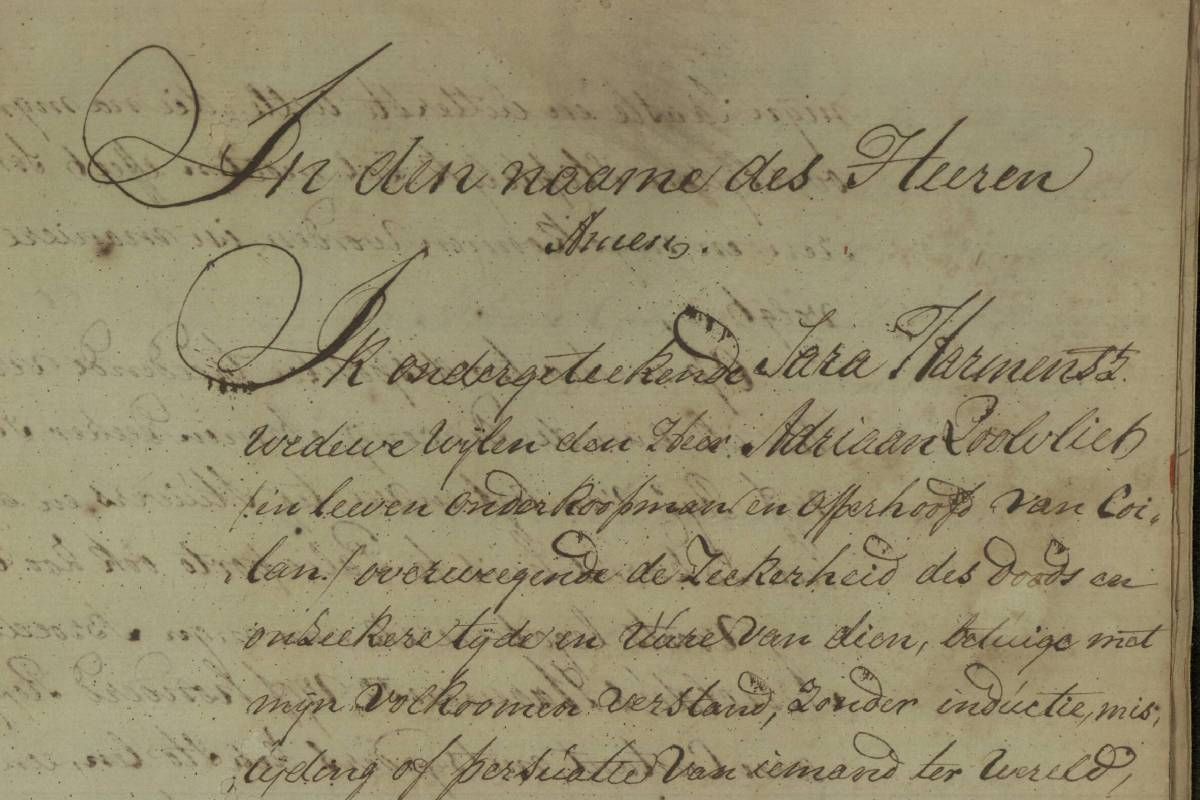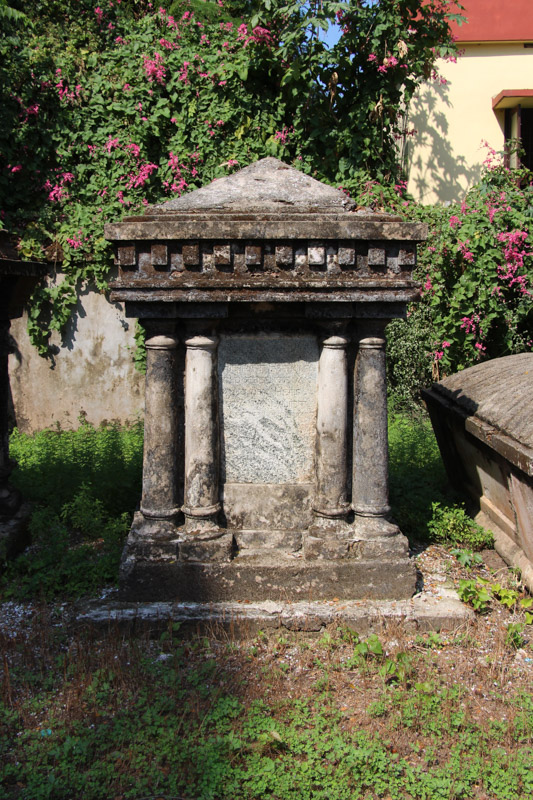
Fort Kochi - Adriaan Poolvliet (bef.1736-1799)
Adriaan Poolvliet was born before 1736 in Cananor and died on 10 September 1799 in Kochi. His parents were the surgeon François Poolvliet van Cochin[i] and Francina Danzer.
Adriaan lost his mother early on. In 1736 his father François had to deposit all the maternal inheritance in the orphanage for his young sons Adriaan and Johannes.[ii] As far as we know, his father has not remarried. Because Adriaan still had his grandmother in the house for a while, it is not inconceivable that this Ina Ringenkamp, also a young widow of François Poolvliet Sr., already lived in the house with her son. Because Francois Jr. spent a large part of his life in Cananor, this partly escapes the administration of Kochi.
Adriaan entered the service of the VOC in 1752 as a soldier for a wage of 9 guilders a month. That same year he was promoted to assistant for 9 guilders a month. In 1755 he became an assistant for 16 guilders and in 1758 for 24 guilders a month. In 1775 he became a sworn clerk of police and justice. He often acted as a writer for wills and official declarations. He would eventually become a junior merchant and chief of Coylan and Cananoor.
On 10 June 1759, Adriaan Poolvliet married Anna Beatrix van Suijlen. Soon Anna was pregnant and on 10 April 1760 their daughter Anna Beatrix was baptized. Unfortunately, the young mother did not survive the birth of her daughter. The daughter also died young.
Adriaan married for the second time. Now with Sara Harmensz. They also baptized a daughter. Francina Elisabeth was baptized on 21 May 1769. Unfortunately, she would also die young. In 1798, Adriaan was at least 62 years old, the couple took in the orphaned girl Elisabeth Ernestina Kautz of one and a half years old. Most likely the daily care for her was done by the enslaved women they had in the house and Clarinda, the enslaved maid of Elisabeth's parents whom they had bought at the estate sale of Johan Casper Kautz. Adriaan would die less than a year later.
 Monument for Adriaan Poortvliet (photo René ten Dam, 2020)
Monument for Adriaan Poortvliet (photo René ten Dam, 2020)
The monument for Adriaan Poolvliet on the Dutch Cemetery in Fort Kochi has a classic design in the form of a cippus with temple-like elements, such as pilasters and a frieze withblock elements. The text is still readable with some effort. It reads: Hier rust het kil en / oud gebeente van / wijlen den heer / Adriaan Poolvliet / In leeven onderkoop / man en gen. Opperhoofd van / Koilan en Kannanoor obiit / 10 september 1799. In translation: Here rests the chill and / cold bones of / the late sir / Adriaan Poolvliet / In his life junior merchant / and gen. Director of /
Koilan and Kannnoor died / 10 September 1799.
In 1806 Sara Harmensz also lost her strength and she had her will drawn up. That gives a good insight into her existence. As a first act she determined that her funeral should be arranged by Johannes Wolff. Her affection for the couple is apparent from the fact that his wife Sara is also mentioned in the will and was given a diamond ring. Her brother Arnoldus Harmansz received 500 rupees, 6 chairs, a table, two chests and her garden with the house in which he now lived. In addition, 2,500 rupees had to be put on interest from which his maintenance could be paid.
She also donated to her adopted child Elisabeth Ernestina Kautz, daughter of the late Johan Casper Kautsz, 4,000 rupees and the jewels of gold and silver that had been made for her. Her diamond breastpiece, a pair of earrings, a pair of hand braces and rings, 3 strands of the largest pearls, a golden amber orb, and the enslaved maid Clarinda she bought from her father at the sale. In addition, she had to be dedicated to her friend Franscina Beek widow of Mr. Berger for a good education. Her remaining capital was to be put on interest and given monthly to Miss Berger to support her foster daughter. If Miss Rottler (her grandmother) were to summon her, and she would send an honest and trusted person to take her by land to Tranquebaar (or wherever she might reside), she might, but not against her will. If Miss Berger felt too old for the upbringing, it should be Miss Queiros. Should the child have to leave, her capital was to remain here until her marriage.[iii]
She donated to all the children whose baptism she witnessed an amount varying between 100 and 1,000 rupees. She drew up a list of eighteen names. The only boy among them, Simeon Coenraads, was given a diamond ring for a gentleman, a rattan with a gold button, a gold watch chain, a pair of gold shoe and trouser buckles and a gold neck buckle. Undoubtedly things that had previously belonged to her husband Adriaan.
After her death she did not want to be washed by enslaved people, but appointed the four widows Dermer, Van de Snoek, Taelee and Maria de Queiros widow Muller. She also wanted a memoriam drawn up in Portuguese.
She meant well for her enslaved ones. The five natives (children of enslaved women born in her home) were each given 200 rupees to put on interest so that they could have something in their marriage. 4 enslaved women were each given 1,000 rupees to put on interest. All enslaved had to be given their freedom and together were given the coconut tree garden and plank house, located in 'Chakkugatty', as their home with everything in it. They were not to pawn, alienate, or sell it, but dwell in it all their lives, and let the fruits and income thereof be for the benefit of all until the surviving of them shall possess it as their pure property. It was the wish that her departed maid Aspazia, with the consent of the other, may also live there if she behaves well. In itself a very noble aim that certainly deserves attention in the current discussion about slavery. 15 enslaved are mentioned by name, but possibly some remained unnamed. It is to be hoped that as free people they have managed to make a success of their business.
The universal heirs of Sara Harmrnsz turned out to be Izabel Adriana de Krouse, widow of Daniel van der Sloot and Izabella Dupré, wife of Joachim Marques de Queiros. In addition to the enormous value of all her possessions, she also had outstanding bills of exchange worth more than 50,000 rupees. Sara died 13 September 1807. One thing is certain. Adriaan was never able to earn his wealth with only his salary from the VOC.
Notes
[i] François (Frans) Poolvliet was born around 1701 in Cochin as the son of the chief surgeon on the coast of Malabar François Poolvliet and Ina Ringenkamp. He entered the service of the VOC on 15 July 1718 for a soldier of 9.00 guilders per month and left for C(h)ettua as a young surgeon. He asked permission on 21 May 1732 to marry the married daughter of the warehouse master Verveerd. At the age of 52, he resigned due to visual impairment. He died 28 March 1759 in Cochin.
[ii] NA 1.11.06.11.286 scan 0008
[iii] NA 1.11.06.11.1494 scans 117 up to 143
Header: will of Sara Harmensz. NA 1.11.06.11.1494 scan 117
- Last updated on .


